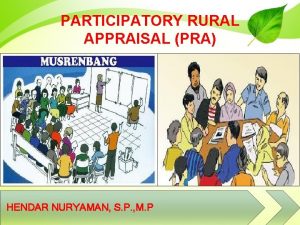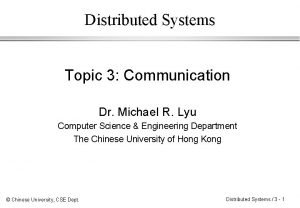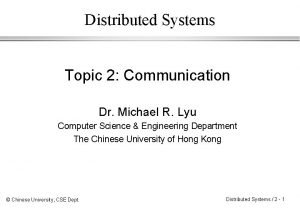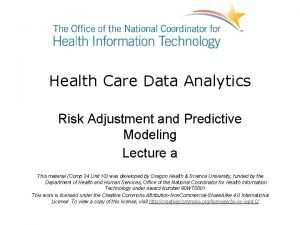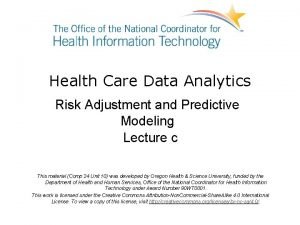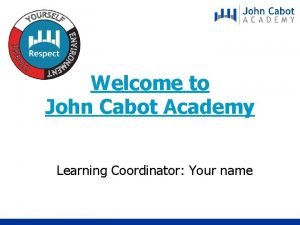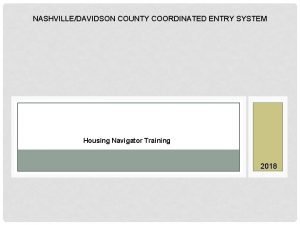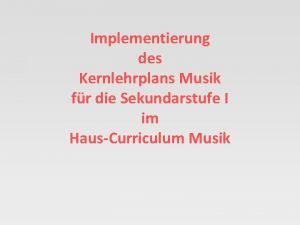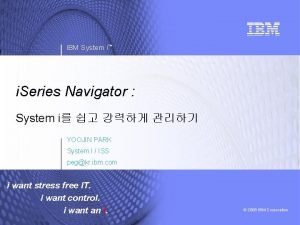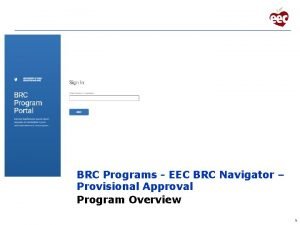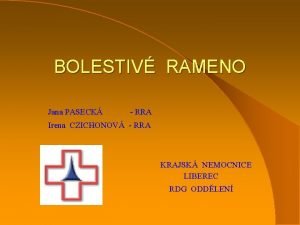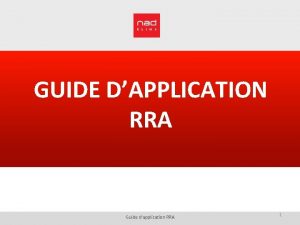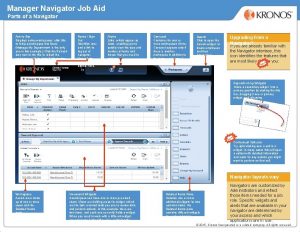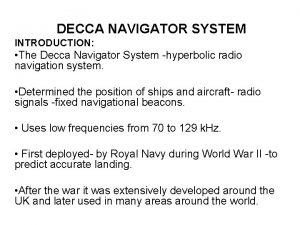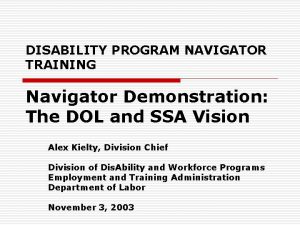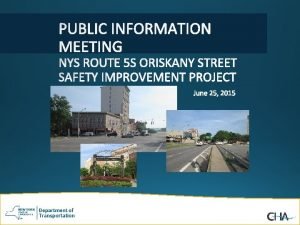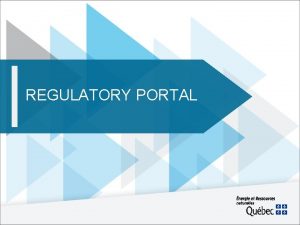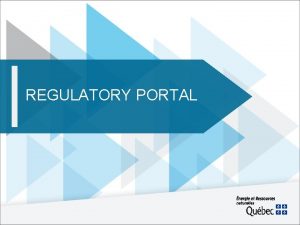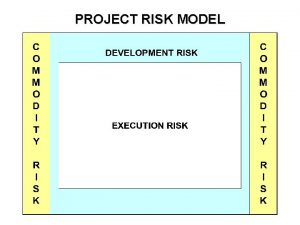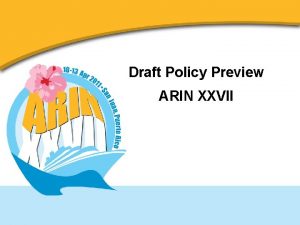DRAFT Project Navigator Regulatory Risk Analytics RRA Prepared
























- Slides: 24

DRAFT Project Navigator Regulatory & Risk Analytics (RRA) Prepared by Seth Aslin for Essex Business School Date: February 2014 PUBLIC

Presentation Outline · Background and context to Project Navigator · General project objectives · Project scope · Overall approach (and rationale) · Rapid prototyping · MATLAB-based policy simulator · Lessons learned (so far!) 2 PUBLIC

Background / Context · 2012 saw HSBC initiate a period of strategic consolidation from a commercial, operational and technical perspective · For the global risk function, Regulatory Risk and Analytics, this has meant: – a stronger focus at the centre of the organisation in London, coordinating risk-related projects in multiple countries and within multiple regulatory jurisdictions – Increasing the level of standardisation across risk methodologies, technologies, governance formats and data models · WCMR / RRA has an objective to improve the ‘consistency’ of the global rating system and has embarked on a programme of system-wide change to achieve this consistency · Several separate projects contribute to the Consistency Programme – Project Navigator is one such initiative · Project Navigator is focused on improving rating assignment – the process of selecting the appropriate ‘path’ for a rating to take through the various models and rating modifiers that comprise the overall rating system 3 PUBLIC

Tactical Heat Map for Project Navigator RRA ENTERPRISE ARCHITECTURE (Wholesale Credit) Credit Approval Workflow Engine Obligor Data + Capture Relationship Management RATING PLATFORM Systemic Risk Measurement Stress Testing Development Model Selection Process Model Engine Calibration Engine Parental Support Framework Validation Model Landscape PD Models CAL Solution Sovereign Ceiling LGD Models HSBC MRS CRR / PD Outputs EAD Models Rating Phil. Sovereign Support Rating Meta-Data Override Process Account Data Rating Process Legal and Risk Hierarchies Credit Approval Processes DATA Entity Identifiers Monitoring / Model Management Model Policies and Standards and Governance Processes Credit Policy / FIM Development Planning and Management Validation Planning / Mgt Credit Risk Strategy Development Process Calibration Process Validation Process Rating Process Design Development Resources Calibration Resources Validation Resources 4 PUBLIC Data Policy Data Models

Project Objectives · The project’s high level objectives are: (1) To formalise and improve the logic used in determining a given wholesale rating’s assignment strategy, including the effects of any rating modifiers, towards the final rating; (2) To automate this logic via algorithms embedded in the banks primary rating systems 5 PUBLIC

Project Scope · The following aspects of the rating system are in scope: 1. Rating assignment strategy – the overall strategy that determined the basis for a rating, including any models, modifiers, etc used in the determination of the rating 2. Rating Model Selection – the process of objectively selecting a model to rate an obligor based on (1) the borrower’s attributes and (2) the collective scope set of the current PD models 3. Parental Support Framework (the ‘PSF’) – the replacement of a stand-alone rating with a parent’s rating (or notched derivation) 4. Sovereign Ceilings – the application of a ceiling to obligor ratings due to (principally) transfer and convertibility risk (‘T&C’ risk) 5. Risk Hierarchies/Networks – recognising the effects of control, and economic interdependency, through networks of relationships 6. Rating event audit trails – implementing an information rich body of meta-data that captures and accurately reflects all of the attributes, decisions and thresholds that led to the final rating 6 PUBLIC

Overall Project Approach · Solve all related problems within the same cycle (= ‘anything to do with rating assignment’) · Form a cross-functional team from Credit Strategy, Policy, Analytics, Technology · Project attributes: – – High complexity (especially in the interaction between components) Unknown levels of regionally-based variation in requirements and regulatory constraints Rapid changes anticipated throughout project Aggressive timelines set by senior management · Our conclusion: use a simulator … a policy simulator … in a rapid prototyping mode · A simulator implies coding … but what sort of code exactly? – In what language? – With what structure? – Developed in what environment? 7 PUBLIC

‘Rapid Prototyping’ (RP) · Complementary to other conceptual frameworks (RAD, Lean, DES, Agile, TDD, CAD/CAE, etc) · Most business problems are amenable to this family of techniques · Many ways to characterise RP (next slide) · Our approach: highly abstract, virtual prototype (in object-oriented code), for design + problem solving · All development characterised by fast, short, exploratory cycles · Abstraction is key – strip away all extraneous content, find the ‘essential core’ of the problem · Use of high level languages is key · Rapid iteration through solutions – short cycles are key for some modes of RP · Data: – Empirical – Experimental – Synthetic 8 PUBLIC

Categorising / Characterising RP · Purpose: – – – – Exploring ideas Design / design validation Problem-solving Requirements-gathering / product specification Consensus-building Time/cost estimation, time/cost reduction Parameter-approximation …etc · Degree of abstraction – High abstraction: reduction of detail and domain content, emphasis on mathematical aspects, increased use of symbolic formalisms, or selective subset simulation – Low abstraction: = ‘high fidelity’, the prototype is highly representative of the final system or product, and/or covers a full system · Form (/Medium): – Physical prototypes – Virtual / soft prototypes 9 PUBLIC

What is a ‘Prototype’? · Informally, there are many related terms: – – – – Simulation Mock-up Proof-of-concept Trial Pilot Model Micro world Scenario engine · Working definition of a prototype (or prototype equivalent): – – – An abstraction of a real world system, object or phenomenon… …that is cheaper and faster to construct than its real-world counterpart… …and whose form, functionality and attributes… …can support a wide range of management processes… …and whose most fundamental effect is to reduce risk and accelerate organisational learning 10 PUBLIC

Advantages of the Rapid Prototyping approach · Test a large number of concepts, options, strategies and configurations at: – …very (or relatively) high speed and/or at – …very (or relatively) low cost · Virtual prototypes are a platform for using more advanced approaches to problem solving and design (e. g. evolutionary programming) · Uncover problems in design / improve design early in a project · Capture requirements and manage key trade-offs in a sophisticated, integrated manner · Build consensus and create shared mental models on key issues · Help a broad (non-technical) audience to visualise an idea, a problem, or a projected outcome · Socialise an issue (then crowd-source the solution) · Manage complexity – uncover dependencies, unusual dynamics, ‘emergent properties’ · Reduce the risk of making a catastrophic decision 11 PUBLIC

Abstraction · Selecting a level of fidelity that suits the purpose of the prototype, and stays inside the ‘envelope’ · Multiple formalisms involved: – – – Narrative policy Flow charts Rule sets Propositional logic / calculus Linguistic formats (if/then…) · Conversion (translation) process is a critical aspect · Setting system boundaries · Short cycles are essential to maximise RP yield 12 PUBLIC

Data Required (General) · The data used within the project is a mix of (1) synthetic and (2) actual · Synthetic cases will be designed to systematically test assumptions and critical points in the proposed solution · These cases may be generated using a statistical technique that is designed to ‘exhaust’ all of the main permutations and dimensions of a problem · Some level of actual data (cases) will be captured because: – They symbolise or represent specific, benchmark cases to key stakeholders – They are known to be problematic cases that are difficult to resolve algorithmically – They highlight known vulnerabilities in the current system – They symbolise or highlight an ambiguity in policy and/or strategy 13 PUBLIC

Considerations Particular to Navigator Points to consider: 1. modular-but-interrelated nature of the core problems… 2. unknown location of final solution(s)… 3. the requirement to conceive, implement and test certain algorithms… 4. a need to somehow process a large number of policy ideas (rating scenarios)… 5. the need to visualise results quickly and easily… 6. the need for several people to work on the problem simultaneously, passing fragments of code around and then integrating them into the simulator… 7. plus a maintainability burden due to high levels of changes within the project… … all implied that (1) an object-oriented approach in (2) an interpreted environment would be ideal · MATLAB in its object-oriented mode is almost perfectly designed for this sort of work 14 PUBLIC

De-romanticising the Development Process Traditional (idealised) development cycle: … …and what can happen in practice: 1. 2. 3. 4. 5. 6. 7. 8. 9. 10. 11. 12. 13. 14. 15. 16. 17. Business problem identified High level solutions generated Formal requirements elicited Functional specification drafted Development Internal testing User Acceptance Testing (UAT) Release to production 15 Identify business problem High level solutions generated Formal requirements elicited Functional specification drafted Development … logical problems in business concept uncovered … minor/major revisions to key concepts. . . re-commencement of development Internal testing User Acceptance Testing (UAT) … further concept revisions arising from UAT … remedial development work … additional (hopefully final) round of UAT Release to production … bugs identified from the live environment … remedial programming … re-release PUBLIC

High-Level Structure of Problem Solving Process · Identify issues (central themes, specific problems, etc) · Frame issues as rating scenarios requiring a formal resolution · Examine and set the HSBC ‘house view’ on key issues · Define the solution for each rating scenario (potentially involving a wider group of stakeholders) · Convert rating scenarios into benchmark test cases and/or map them on to actual cases · Generate an array of additional test cases to probe solution boundaries · Code the solutions into the simulator (directly altering modules to reflect solutions, policies, etc) · Run the test cases through the simulator, collate · Review strategies and solutions 16 PUBLIC

Central Work Cycle Project Scope Key Scenarios Issues List Test Cases Candidate Solutions Classes Active Components (Objects): 1. 2. 3. 4. 5. 6. Obligor object Model landscape object (collective scope set) Rating model selection (RMS) Parental Support Framework (PSF) Sovereign Ceiling (SC) Effective Risk Hierarchy / Network (ERH) object Simulator Key Results (per case): Results 1. CRRs 2. Rating ‘path’ 3. Intermediate states Conclusions Selected Solutions Resolved Scenarios High-Level Requirements Functional Specification 17 Policy Changes PUBLIC

Simulator: Operating Modes Object-based code library ‘DOE’ Script Monte Carlo Single Cases Excel N ΔRWA% GUI ‘Q-Space’ Dash RWA Engine 18 Distribution Analysis PUBLIC Case Review

Class Library Overview 19 PUBLIC

Navigator Class Library · Relatively large number of classes given the number of sub-problems involved · High levels encapsulation of every functional aspect of the Navigator project · Namespaces (packages) and class folders used to organise code · Methods written to keep the ‘public interface’ as clean / standard / logical as possible · Delegation principle followed to keep the classes as loosely coupled as possible · Collections of objects used for managing the rating model selection problem · Classes become natural ‘locations’ or ‘hooks’ for key algorithms (e. g. classification, matching, etc) · ‘Composition’ based relationships fairly common (very little ‘inheritance’ at this stage) · Boundary elements (classes) are mock objects for future interfaces, and points of integration 20 PUBLIC

Visual Scenario Template 21 PUBLIC

Test case 001 (example only) 22 PUBLIC

Lessons Learned · High level languages are brilliant prototyping environments – especially for non-programmers! · Scripting is seductive but the discipline of classes/objects is worth the effort · Class libraries are time-consuming to create in the first place but the modular structure has already shown benefits · MATLAB’s object-oriented syntax is clean, simple and easy to understand · We have found pure ‘test driven development’ (TDD) to be a challenging approach to maintain in the face of (very) high ambiguity and (rapidly) changing requirements · We prefer a sort of loose, informal prototyping that proceeds from idea scripts & functions script-facilitated classes wrapped in a GUI-managed session (a quasi-app) · We’ve learned through experience to integrate as continuously as possible · GUIs are extremely simple to code in MATLAB – we recommend building GUIs for any repetitive task (and make the decision early to build them) · Important to position the prototype correctly in people’s minds and to manage organisational dynamics that surround it 23 PUBLIC

Closing Points · RP is not just for engineering problems! · RP has broad utility for framing and solving problems, as well as facilitating decision making · Be open to learning some of the formalisms that are more associated with mathematics (and modelling in general) · Learn to code! · Even small problems have a lot of hidden complexity – simulation / RP can uncover these · Become familiar with patterns of risk inside projects, and conversant in the methods that have proven to manage these risks 24 PUBLIC
 Object of draw frame
Object of draw frame Credit risk market risk operational risk
Credit risk market risk operational risk Contoh rra dan pra dalam penyuluhan pertanian
Contoh rra dan pra dalam penyuluhan pertanian Ra re ri ro ru
Ra re ri ro ru Nad klima rra
Nad klima rra R rr rra protocol
R rr rra protocol R rr rra protocol
R rr rra protocol Btec sport level 3 unit 3
Btec sport level 3 unit 3 Teramond
Teramond Descion tree
Descion tree Predictive analytics risk adjustment healthcare examples
Predictive analytics risk adjustment healthcare examples Predictive analytics risk adjustment healthcare
Predictive analytics risk adjustment healthcare John cabot academy navigator
John cabot academy navigator Prince henry the navigator ap world history
Prince henry the navigator ap world history Kuder navigator
Kuder navigator Henry the navigator map
Henry the navigator map Pin navigator
Pin navigator Housing navigator training
Housing navigator training Medienkompetenz navigator
Medienkompetenz navigator Lehrplan navigator
Lehrplan navigator System i navigator
System i navigator Aws wind navigator
Aws wind navigator Nuclide navigator
Nuclide navigator Spain and portugal
Spain and portugal Brc navigator
Brc navigator


